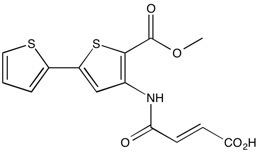HTS01037 | FABP inhibitor
NMR (Conforms)

Available Options
| Size : | Price | Quantity | |
|---|---|---|---|
| 5 mg | $60.00 | ||
| 25 mg | $240.00 |
HTS01037 (682741-29-3) inhibits fatty acid binding proteins. Inhibits lipolysis in 3T3-L1 adipocytes and reduces LPS-stimulated inflammation in cultured macrophages. Acts as an antagonist of the protein-protein interaction between AFABP/aP2 and hormone sensitive lipase but does not activate PPARg in macrophages.1 Inhibits FABP-dependent and fatty acid-stimulated leukotriene C4 biosynthesis.2 Reduces intracellular free fatty acid levels, lowering macrophage inflammation and ER stress.3 Reduces LPS-stimulated IL-1b secretion in a mouse model.4 Inhibits VLDL-induced foam cell formation.5
References/Citations:
1) Hertzel et al. (2009), Identification and characterization of a small molecule inhibitor of Fatty Acid binding proteins; J. Med. Chem, 52 6024
2) Long et al. (2012), Fatty acids induce leukotriene C4 synthesis in macrophages in a fatty acid binding protein-dependent manner; Biochim. Biophys. Acta, 1831 1199
3) Xu et al. (2015), Uncoupling lipid metabolism from inflammation through fatty acid binding protein-dependent expression of USP2; Mol. Cell. Biol., 35 1055
4) Steen et al. (2017), FABP4/aP2 regulates macrophage redox signaling and inflammasome activation via control of UCP2; Mol. Cell. Biol., 37 e00282
5) Boss et al. (2015), FABP4 inhibition suppresses PPARgamma activity and VLDL-induced foam cell formation in IL-4-polarized human macrophages; Atherosclerosis, 240 424
NMR (Conforms)
Safety Data Sheet:
Product Data Sheet:
Materials provided by Focus Biomolecules are for laboratory research use only and are not intended for human or veterinary applications. Please note that we do not sell to individuals and that all orders placed by non-research organizations will incur a $20 restocking/refund fee
HTS01037 (682741-29-3) inhibits fatty acid binding proteins. Inhibits lipolysis in 3T3-L1 adipocytes and reduces LPS-stimulated inflammation in cultured macrophages. Acts as an antagonist of the protein-protein interaction between AFABP/aP2 and hormone sensitive lipase but does not activate PPARg in macrophages.1 Inhibits FABP-dependent and fatty acid-stimulated leukotriene C4 biosynthesis.2 Reduces intracellular free fatty acid levels, lowering macrophage inflammation and ER stress.3 Reduces LPS-stimulated IL-1b secretion in a mouse model.4 Inhibits VLDL-induced foam cell formation.5
References/Citations:
1) Hertzel et al. (2009), Identification and characterization of a small molecule inhibitor of Fatty Acid binding proteins; J. Med. Chem, 52 6024
2) Long et al. (2012), Fatty acids induce leukotriene C4 synthesis in macrophages in a fatty acid binding protein-dependent manner; Biochim. Biophys. Acta, 1831 1199
3) Xu et al. (2015), Uncoupling lipid metabolism from inflammation through fatty acid binding protein-dependent expression of USP2; Mol. Cell. Biol., 35 1055
4) Steen et al. (2017), FABP4/aP2 regulates macrophage redox signaling and inflammasome activation via control of UCP2; Mol. Cell. Biol., 37 e00282
5) Boss et al. (2015), FABP4 inhibition suppresses PPARgamma activity and VLDL-induced foam cell formation in IL-4-polarized human macrophages; Atherosclerosis, 240 424
Calculate the molar concentration, mass or volume in a solution.
Concentration × Volume × Molecular Weight = Mass
Focus Biomolecules • Plymouth Meeting, PA USA • 1-855-FOCUS21
Focus Biomolecules
Plymouth Meeting, PA USA
1-855-FOCUS21
Website Created by Advanta Advertising LLC.

